This year’s festival came to a close with a salute to the man Eddie Muller called not a noir actor but a noir artist: Richard Widmark.
I’d been itching to see Slattery’s Hurricane since reading Eddie’s article about it in the Noir City Sentinel, the magazine of the Film Noir Foundation. It’s the least known of Widmark’s films from this era, and is also the only original screenplay by novelist Herman Wouk.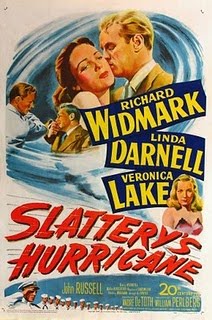 Here’s your slambang opening: Widmark’s Slattery coldcocks a guy, steals a plane, and flies directly into the titular windstorm. The ex-Navy pilot then reflects back on the life that brought him to this point. Think of it as a borderline psychotic version of The Spirit of St. Louis. The long chain of circumstance involves Slattery’s fragile girlfriend Veronica Lake; his ex-lover Linda Darnell, now married to an old pal; and a “candy” company that didn’t hire Slattery to fly to the Caribbean to pick up cocoa leaves.
Here’s your slambang opening: Widmark’s Slattery coldcocks a guy, steals a plane, and flies directly into the titular windstorm. The ex-Navy pilot then reflects back on the life that brought him to this point. Think of it as a borderline psychotic version of The Spirit of St. Louis. The long chain of circumstance involves Slattery’s fragile girlfriend Veronica Lake; his ex-lover Linda Darnell, now married to an old pal; and a “candy” company that didn’t hire Slattery to fly to the Caribbean to pick up cocoa leaves.
Very adult stuff, so naturally it ran head-on into opposition from the censors. Eddie correctly called this “a wounded film,” with much of the strongest material excised or heavily edited. Still, those phantom limbs are felt. You can see the movie that Slattery’s Hurricane was meant to be, even though it doesn’t play out onscreen. Widmark’s bristling performance holds the enterprise together, as do the harrowing flight sequences; director André De Toth was a pilot, even though he only had one eye. Lake, then married to De Toth, appears without her trademark hairstyle and is shockingly vulnerable. She would never star in a major studio film again.
Next: Pickup on South Street, one of the best B movies ever made and one that lost its FBI seal of approval because of writer/director Samuel Fuller’s affection for characters scrabbling out an existence in the margins of society.
We’ve seen Pickup several times, so we skipped the screening to have one last round (or two) of drinks with the Czar of Noir and settle up. Rosemarie and I sold hundreds of dollars worth of FNF merchandise during the run of the festival, and were down to the dregs by closing night. It may not be as impressive as the haul the Foundation takes down during Noir City San Francisco, but that festival is in the 1400-seat Castro Theater and has cigarette girls moving the merch in the aisles. Seattle had two people at a table, and that cigarette girl costume chafed something fierce.
My thanks again to Eddie, the FNF, and SIFF Cinema for what has been the most successful Noir City Northwest yet. Great films and strong turnouts all week long. It’s an amazing feeling to watch rarities like Slattery’s Hurricane or Wednesday’s Fly-By-Night and realize that the only people in the world seeing that movie on that day are in the room with you.
Noir City rolls into Los Angeles in April, and elsewhere later this year. Do yourselves a favor: watch The Endless Night, which received an encore screening yesterday, then go to the Film Noir Foundation website and kick in a few bucks. (UPDATE: Or buy the swag that Rosemarie and I were selling, including Annual #2 in which I appear.)
Time for me to catch up on some more current movies.
Friday, February 26, 2010
Noir City Northwest: Slattery’s Hurricane (1949)
Thursday, February 25, 2010
Noir City Northwest: Deported (1950)/Fly-By-Night (1942)
Few names are more revered in the annals of film noir than that of Robert Siodmak. He directed some of the classics of the form: Phantom Lady, The Killers, Criss Cross. Last night Eddie Muller showed a pair of rarities that bookend the noir and Hollywood phases of Siodmak’s career. Neither one is exactly noir, but both are fascinating.
The German expatriate was considering a return to Europe when he was offered Deported. One of the few studio films to be shot overseas at the time, it’s a fictional account of Lucky Luciano’s forced return to Italy following his cooperation with the U.S. government during World War II. From prison, Charley Lucky used his control of the waterfront rackets to shut down Axis spies, and his contacts in Italy provided intelligence during the run-up to the invasion.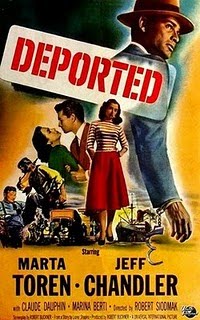 “Vic Smith,” aka Victor Sparducci, (Jeff Chandler) isn’t a player at Lucky’s level, but he did do his bit to help Uncle Sam during the war. Now he’s being sent back to the country he barely remembers, watched by the police and hounded by an ex-partner. As he falls for a beautiful contessa (the Swedish actress Märta Torén), he hatches a brilliant plan to bring the hundred grand he stashed in New York into the country.
“Vic Smith,” aka Victor Sparducci, (Jeff Chandler) isn’t a player at Lucky’s level, but he did do his bit to help Uncle Sam during the war. Now he’s being sent back to the country he barely remembers, watched by the police and hounded by an ex-partner. As he falls for a beautiful contessa (the Swedish actress Märta Torén), he hatches a brilliant plan to bring the hundred grand he stashed in New York into the country.
Deported is an authentic curio, and I liked it quite a bit. It feels like a European film, moving at a different rhythm. There are some striking scenes of Italy shot by William Daniels, and a sense of the deprivation there after the war. I must mention Marina Berti, bewitching as Gina. The apocryphal story is that Luciano, a die-hard movie fan, met with Siodmak during production to tell him how much he loved The Killers ... and that Siodmak used him as an extra in a movie based on his own life. I didn’t spot him, but then I wasn’t looking for him.
Siodmak burst of the B movie ghetto with Fly-By-Night, a blatant attempt to cash in on Alfred Hitchcock’s success The 39 Steps. Here the innocent man caught up in espionage is played by Richard Carlson, who would go on to be a ‘50s sci-fi stalwart in It Came From Outer Space and Creature From the Black Lagoon. Nancy Kelly, mother of The Bad Seed, is the gal along for the ride.
The script, by one of my heroes Jay Dratler, manages to hit all the comic suspense notes in diabolically inventive ways. And Siodmak stages some impressive stunts on a limited budget. It’s easy to understand why he was earmarked for bigger things. Fly-By-Night is a treat, one of the best faux-Hitchcock films ever made.
Alas, there is exactly one (1) print of the movie in existence. Last night, it unspooled in Seattle.
Wednesday, February 24, 2010
Noir City Northwest: Red Light (1949)/Walk a Crooked Mile (1948)
It was a hoarse Eddie Muller who took to the stage on Tuesday night. SIFF, working him like a government mule, has sent him out to preach the gospel of noir at area schools this week. During his visit to Reel Grrls, he showed The Endless Night. First question: “Why is everyone so angry?”
And thus is the next generation of noirheads born.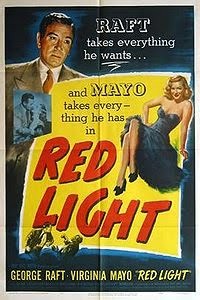 Eddie billed Red Light as biblical noir. He meant this in every sense. A copy of the Good Book is integral to the plot, and there is divine intervention. Trucking magnate George Raft goes on the warpath after his chaplain brother is murdered. It was tough for me to feel his pain because li’l bro is Arthur Franz, who played the title role in The Sniper.
Eddie billed Red Light as biblical noir. He meant this in every sense. A copy of the Good Book is integral to the plot, and there is divine intervention. Trucking magnate George Raft goes on the warpath after his chaplain brother is murdered. It was tough for me to feel his pain because li’l bro is Arthur Franz, who played the title role in The Sniper.
Red Light is a truly odd duck of a film, a tough melodrama shot through with schmaltz and religious undertones. It uses Ave Maria as its action theme. The Coen Brothers must have seen it because Stanley Clements, aka Mr. Gloria Grahame, plays a hotel bellhop who clearly influenced Buzz in The Hudsucker Proxy. There’s also a bizarre flashback featuring a blind veteran and a window washer with no sense of personal space. The script is something of a shaggy dog story; you know exactly how the bible business is going to pay off. But Raft is surprisingly effective within his limited range, and veteran studio hand Roy Del Ruth stages a vigorous ending.
Walk a Crooked Mile was made semi-documentary style, and you know what that means: location shooting and stentorian voiceover. Dennis O’Keefe, joining Dick Powell and John Payne in the parade of song-and-dance men who remade themselves as hard cases, is an FBI agent investigating security leaks at a government energy facility. He teams up with Scotland Yard’s Louis Hayward to smash a red spy ring. A minor but solid suspense film. Director Gordon Douglas also made Frank Sinatra’s Tony Rome movies and Zombies on Broadway starring Bela Lugosi and the comedy team of Brown & Carney, the utterly destitute man’s Abbott & Costello.
Both of last night’s movies were partly filmed in San Francisco and feature Raymond Burr as a villain. Burr’s best known for playing heroic leads in Perry Mason and Ironside, but those TV shows were before my time. I’ve never seen an episode of either one. I’ll always think of Burr as an overweight, sweaty psychosexual lunatic from movies that are even more before my time.
Tuesday, February 23, 2010
Noir City Northwest: Inside Job (1946)/Human Desire (1954)
So about Sunday ... the double feature was devoted to John Garfield. I’ve seen The Postman Always Rings Twice a time or three, and I watched He Ran All the Way not all that long ago – and didn’t particularly care for it. (Great opening 20 minutes, but it gets very stagy very quickly.) Consequently, I chose to forego them both and dine with the czar instead. But I was on hand to sell merch and hear Eddie’s introduction, which touched on how the former Julius Garfinkle spearheaded the Group Theater-born school of naturalistic acting that prefigured Clift, Brando and Newman; Postman’s transformation from the definitive work of noir fiction to high-class women’s picture; and the blacklist’s effect on the careers of everyone involved with He Ran All the Way. When Eddie wrapped up by noting that he’s in regular contact with Garfield’s daughter and she asked him to tell the audience, “Julie sends his love,” I almost regretted my decision. I’ll revisit Postman again soon.
Monday’s movies? Both brand new to me.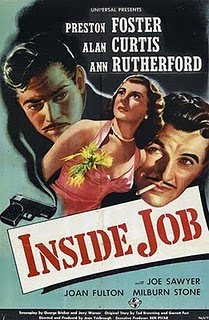 The authentic B picture Inside Job was aptly described by Eddie as “67 minutes of craziness.” Ex-con Alan Curtis, coerced by his old boss into robbing the department store where he’s working a straight gig, opts to hit the joint himself with wife Ann Rutherford. Sounds noir, right? Well, it ain’t. I don’t know what to call Inside Job other than baffling. Featuring a photo of a Robert Benchley lookalike in a bathing suit and the most annoying child actor in screen history. Curtis is the target of a police dragnet, but when he goes out in broad daylight – to buy a radio, yet – he doesn’t bother to shave off his distinctive mustache. Which I can understand; without the ‘stache, even the camera wouldn’t notice him. The truly downbeat ending makes it the weirdest Christmas movie ever. Tod Browning is credited with the story, the last time the legendary horror director’s name appeared on a film.
The authentic B picture Inside Job was aptly described by Eddie as “67 minutes of craziness.” Ex-con Alan Curtis, coerced by his old boss into robbing the department store where he’s working a straight gig, opts to hit the joint himself with wife Ann Rutherford. Sounds noir, right? Well, it ain’t. I don’t know what to call Inside Job other than baffling. Featuring a photo of a Robert Benchley lookalike in a bathing suit and the most annoying child actor in screen history. Curtis is the target of a police dragnet, but when he goes out in broad daylight – to buy a radio, yet – he doesn’t bother to shave off his distinctive mustache. Which I can understand; without the ‘stache, even the camera wouldn’t notice him. The truly downbeat ending makes it the weirdest Christmas movie ever. Tod Browning is credited with the story, the last time the legendary horror director’s name appeared on a film.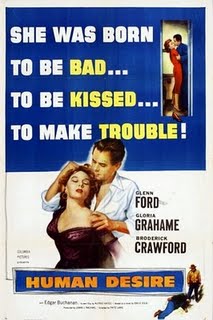 It was unfair of Eddie to show a Fritz Lang movie next. The opening sequence of Human Desire, showing train engineers at work, is more suspenseful than all of Inside Job ... and nothing is happening. The film is based on Émile Zola’s 1890 novel La Bête Humaine, previously filmed by Jean Renoir in 1938. Glenn Ford, an actor Noir City has taught me to appreciate, is a Korean war vet returning to his railway job. He falls for the wife of colleague Broderick Crawford, unaware that her interest in him is spurred by the need to cover up a murder Crawford has committed.
It was unfair of Eddie to show a Fritz Lang movie next. The opening sequence of Human Desire, showing train engineers at work, is more suspenseful than all of Inside Job ... and nothing is happening. The film is based on Émile Zola’s 1890 novel La Bête Humaine, previously filmed by Jean Renoir in 1938. Glenn Ford, an actor Noir City has taught me to appreciate, is a Korean war vet returning to his railway job. He falls for the wife of colleague Broderick Crawford, unaware that her interest in him is spurred by the need to cover up a murder Crawford has committed.
Human Desire is another showcase for Gloria Grahame and her stiletto vulnerability. The psychology of her character is so dark that the movie itself seems frightened of it. The beautiful quality of the print only emphasized the truncated scenes and abrupt ending. For its occasional skittishness, however, Human Desire has intensity and atmosphere to spare. From Fritz Lang, I would expect no less.
Sunday, February 21, 2010
Noir City Northwest: Cry Danger (1951)/The Mob (1951)
It’s good to see your money at work.
The Film Noir Foundation takes its mission seriously, funding restorations of movies that would otherwise be lost. Organization capo Eddie Muller explained the many hurdles in the process before the Northwest premiere of the Foundation’s latest effort, done in conjunction with the UCLA Film & Television Archive. Because Cry Danger was produced independently by star Dick Powell, it was at genuine risk of disappearing. The FNF’s intervention has given this underrated film – and VKDC favorite – a new lease on life.
Powell’s Rocky Mulloy is released from prison after serving five years on a robbery charge when a witness resurfaces to back up Rocky’s claim of innocence. That the witness has never seen Mulloy before and alibis him only in the hope of making a few bucks is the first indication that Cry Danger isn’t going where you expect. Rocky looks up Rhonda Fleming, his ex-flame/current wife of his still-in-stir pal, and sets his sights on the man behind the frame, the “now 60% legit” Louie Castro (William Conrad).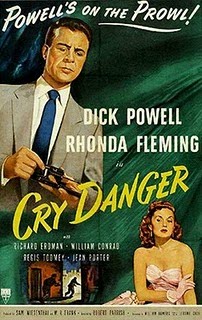 William Bowers’ script is a marvel of construction, especially as it was written with producer Powell looming over his shoulder. (“We just lost another fifty grand from the budget. Cut something.”) Cry Danger’s greatest asset is the character of Powell’s unlikely savior DeLong, a bibulous one-legged Marine and thinly-veiled self-portrait of Bowers. Richard Erdman gives what I rank as one of the greatest supporting performances of all time, abetted by classic dialogue. (“Occasionally, I always drink too much.”) Erdman is not only still acting, he has a recurring role on NBC’s Community as one of Greendale CC’s more mature students. Amazing considering his career began with Mr. Skeffington in 1944. Cry Danger is a terrific film well worth saving.
William Bowers’ script is a marvel of construction, especially as it was written with producer Powell looming over his shoulder. (“We just lost another fifty grand from the budget. Cut something.”) Cry Danger’s greatest asset is the character of Powell’s unlikely savior DeLong, a bibulous one-legged Marine and thinly-veiled self-portrait of Bowers. Richard Erdman gives what I rank as one of the greatest supporting performances of all time, abetted by classic dialogue. (“Occasionally, I always drink too much.”) Erdman is not only still acting, he has a recurring role on NBC’s Community as one of Greendale CC’s more mature students. Amazing considering his career began with Mr. Skeffington in 1944. Cry Danger is a terrific film well worth saving.
Bowers and director Robert Parrish next collaborated on The Mob. I saw this film for the first time last year and was floored by it. Eddie explained why it’s not better known: when Columbia’s On The Waterfront became a hit, their earlier, lower-budgeted effort about corruption on the docks was forgotten.
Time for some blasphemy: The Mob is better than On The Waterfront. It’s faster, funnier, more suspenseful and less ... psychological.
Broderick Crawford is a cop sent undercover to investigate the rackets. (“I gotta go underground. You know, like gophers and Communists.”) On his way to identifying mysterious kingpin Blackie Clegg he’ll tussle with an authentic rogue’s gallery: Neville Brand, Ernest Borgnine, John Marley. A young Charles Bronson turns up for a scene. And Bowers’ treatment of Richard Kiley’s character, a too-friendly longshoreman, is an object lesson in screenwriting. A sensational double-bill.
Saturday, February 20, 2010
Noir City Northwest: Pitfall (1948)/Larceny (1948)
A capacity crowd was on hand for the opening night of the fourth Noir City Northwest. Master of ceremonies Eddie Muller gave the new converts the full spiel on the mission of the Film Noir Foundation, dedicated to “preserving America’s noir heritage” and rescuing films from the “poor stewardship” of the conglomerates that own them.
This year’s theme is Lust & Larceny, and the kick-off double bill summed it up nicely. The first four films are also a mini-tribute to screenwriter William Bowers, a longtime VKDC favorite whom Eddie described as the Robert Towne of his day, brought in regularly to punch up scripts.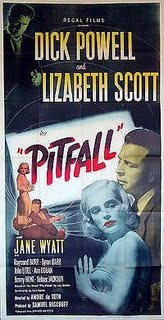 Bowers’ work isn’t credited on Pitfall, but his fingerprints are all over it. Crackling dialogue, sharply-etched supporting players, tight plotting. Married insurance executive Dick Powell is no longer settled with being settled, chafing at his perfect life. A claim brings him in contact with Lizabeth Scott, a good-hearted girl who’s a magnet for men of poor character. Like shady shamus Raymond Burr, who found her for Powell and wants to make his connection with her permanent.
Bowers’ work isn’t credited on Pitfall, but his fingerprints are all over it. Crackling dialogue, sharply-etched supporting players, tight plotting. Married insurance executive Dick Powell is no longer settled with being settled, chafing at his perfect life. A claim brings him in contact with Lizabeth Scott, a good-hearted girl who’s a magnet for men of poor character. Like shady shamus Raymond Burr, who found her for Powell and wants to make his connection with her permanent.
I first saw Pitfall at Noir City several years ago and had a reservation or two about it. That’s because I went in with certain expectations. Revisiting it, I could appreciate Pitfall for the gem that it is. Burr’s character is a stalker plain and simple, played with a modern edge. Lizabeth Scott’s Mona, who does the right thing at every opportunity to no avail, breaks your heart. And Jane Wyatt as Powell’s pragmatic wife may be the hardest nut of them all.
The more light-hearted Larceny is the movie Rosemarie was most interested in because it pairs up two of her favorite actors, John Payne and Dan Duryea. The twosome are part of a ring of con men who set out to fleece grieving war widow Joan Caulfield. There are only two problems: inside man Payne starts falling for Caulfield, and Duryea’s girl, who carries a torch for Payne, arrives to gum up the works. She’s played by Shelley Winters at her brassy best, delivering one Bowers zinger after another. Throw in noir favorite Percy Helton and a slew of lookers pining after Payne, and a good time is had by all.
All that plus the FNF’s beautifully produced 2009 memorial reel and Serena Bramble’s extraordinary The Endless Night: A Valentine to Film Noir. For an amazing price of ten bucks, people. How can you go wrong?
Rosemarie and I are selling FNF merch in the lobby before each show. (She’s the eye candy, I’m the numbers man.) We did land-office business yesterday. Our most popular item is the second edition of the Noir City Sentinel Annual, collecting the best of the pieces that appeared in the FNF’s subscriber newsletter. Eddie’s in there, as is Edgar Award winner Megan Abbott and other luminaries – plus several pieces by yours truly.
Last night, I was asked to sign a copy of the book. That is a personal first that I won’t soon forget.
Friday, February 19, 2010
Noir City Northwest: Your Reminder

This post is basically an excuse to run that banner.
It starts tonight. Here’s the program. You know where I’ll be. If you’re in Seattle, come on out and see two movies for ten bucks. Movies that in many cases aren’t available on video and rarely if ever air on television. Movies presented by the Czar of Noir himself, Eddie Muller. Movies brought to you courtesy of the Film Noir Foundation. Movies the way they were meant to be seen.
And if you’re not in Seattle, I will, in spite of multiple deadlines and an abnormally high tree pollen count, endeavor to bring you the coverage that this website is known for.
Into the shadows we go.
Tuesday, February 16, 2010
Movies: The Red Riding Trilogy (U.S. 2010)
For several reasons, I will keep what had been planned as a lengthy post brief.
See these movies.
OK, not that brief.
David Peace wrote a quartet of novels weaving together a decade’s worth of true crime in the north of England with his own fevered imaginings of corruption, guilt, and the merest glimmers of redemption. Those four books have been condensed into a remarkable trio of films. Each one scripted by Tony Grisoni but helmed by a different director. Characters drift between them, their roles transforming. Loose ends ravel. Mysteries resolve.
You really should see these movies.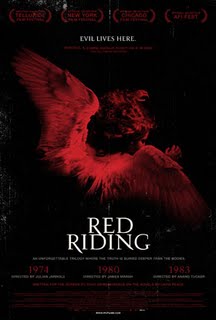 1974 (Julian Jarrold) focuses on a hotshot young reporter who didn’t cut it in London and is back on his old stomping grounds. He’s convinced he’s onto the case of a serial murderer of young girls, and equally certain that this story will return him to the top. The poor sod has no idea he’s stumbled into a nest of tangled motives and vice that has pulled better men down.
1974 (Julian Jarrold) focuses on a hotshot young reporter who didn’t cut it in London and is back on his old stomping grounds. He’s convinced he’s onto the case of a serial murderer of young girls, and equally certain that this story will return him to the top. The poor sod has no idea he’s stumbled into a nest of tangled motives and vice that has pulled better men down.
1980 (James Marsh) sees an outsider arrive, a straight arrow cop (the brilliant Paddy Considine) called on to determine why the local police haven’t apprehended the Yorkshire Ripper. He thinks his history in this neck of the woods will aid him in his endeavors. He is wrong.
1983 (Anand Tucker) finds chickens coming home to roost, sinners struggling to the light, and Shakespeare being proven right: at the length, truth will out.
The series, which aired on U.K. television last year, has been compared to Twin Peaks, The Wire, the collected works of James Ellroy, and Zodiac. All somewhat valid, none truly accurate.
What Grisoni and company have crafted here is an epic vision of evil. Of the domestic variety, petty and insidious, dwelling in institutions, the hearts of men, the landscape itself. It’s a haunting, harrowing piece of work. It’s noir for the 21st century. Yes, you’ll like one film more than the others (I’d opt for 1980 myself). Granted, it’s not perfect. What is? But in its ambition, its execution, its belief in the power of the accretion of detail, its faith in the audience, its sheer fucking adultness, it’s the most thrilling thing I’ve watched in ages.
The movies are being screened around the country, including at Seattle’s Northwest Film Forum, in the coming weeks, often back-to-back-to-back. I pity those who absorb them that way; priests and publicans should be on call. Right now the entire trilogy is available via IFC On Demand, which is how I watched them over the course of three days. It made it easier to weep for my fellow man and rage at an indifferent God. Plus, no parking problems!
Clear your schedule. See these movies. Thank me later.
Monday, February 15, 2010
Movies: Race Street (1948)/Scene of the Crime (1949)
Noir City Northwest kicks off this coming Friday – if you’re in Seattle, come on out and say hello to yours truly at the Film Noir Foundation table in the lobby – and the time has come to get into shape. I’ve been on a vigorous training regimen, running wind sprints, downing extra cocktails. I’ve also got to keep those blogging muscles limber, so here’s a practice post on a pair of films noir.
You know you’re in trouble when William Bendix is the most charismatic member of your cast. That’s where we find ourselves in Race Street. The stolid George Raft is a bookie aiming to go legit in the nightclub business. But close pal Harry-then-Henry Morgan is bumped off when he refuses to pay protection money, and Raft decides to track down the killers himself. Bendix is his childhood friend turned police detective. The story’s no great shakes, and there are some odd directorial choices. Morgan’s potent death scene – a tumble down a brutally long flight of stairs – is ruined by a slow push-in at the end, and there’s a bizarre musical number featuring Raft’s torch singer sis filmed Spike Jonze style without explanation. I have higher hopes for another Raft noir, Red Light, scheduled for the festival.
Sometimes actors can surprise you. Van Johnson gained fame as MGM’s all-American boy, but in Scene of the Crime he’s surprisingly plausible as big city cop Mike Conovan. When his former partner is gunned down under suspicious circumstances Mike sets out to clear his name, even if it means cozying up to former gangster’s moll Gloria DeHaven. All while long-suffering wife Arlene Dahl lobbies him to quit the force altogether, even conspiring with an old beau to land him a cushy private sector job.
Charles Schnee’s script features pungent dialogue (DeHaven is described thusly: “Figure like champagne, heart like the cork”), still-shocking violence, and a nice mix of authentically shady characters, like Norman Lloyd’s stoolie Sleeper. Plus there’s a richness of detail at the margins. The killers are knocking over Syndicate joints, so the Outfit starts staging its own lineups. Moments like that lift Scene of the Crime a rung or two above the ordinary.
Thursday, February 11, 2010
Movie: The Red Shoes (1948)
Patience, ladies and gentlemen, is rewarded.
I had deliberately avoided the landmark Michael Powell/Emeric Pressburger film The Red Shoes on TV because I knew it demanded to be seen on the big screen. Last night I not only watched a gloriously restored new print, but it was introduced by Thelma Schoonmaker, the widow of director Michael Powell and Martin Scorsese’s longtime (and multiple Academy Award-winning) editor. She cut Goodfellas, people.
The film, about a ballet company and the dancer who becomes muse to two men, overwhelmed me. It’s unmatched in its depiction of a collaborative art form and the ways one individual can unite others in service of a vision. The boldness of its filmmaking still astounds. The CGI in, say, Avatar is about making a physical world seem real. The effects deployed in The Red Shoes are used to bring an emotional universe to life. They’re far riskier, and the rewards that much greater when they succeed.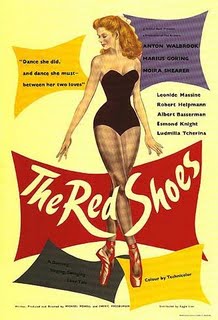 The evening began with a brief before-and-after comparison highlighting the work of the UCLA Film & Television Archive with the support of The Film Foundation. The restoration was an extraordinarily difficult one; The Red Shoes was shot in three-strip Technicolor on a camera so enormous Powell nicknamed it “the cottage.” Over the decades the individual strips shrank at different rates and were damaged by mold. The result is astonishing. Jack Cardiff’s photography contains colors I’d only previously seen on the insides of my eyelids. A single shot of several pairs of the title shoes presented for the approval of the company’s impresario features so many discernable shades of scarlet that it’s almost unseemly.
The evening began with a brief before-and-after comparison highlighting the work of the UCLA Film & Television Archive with the support of The Film Foundation. The restoration was an extraordinarily difficult one; The Red Shoes was shot in three-strip Technicolor on a camera so enormous Powell nicknamed it “the cottage.” Over the decades the individual strips shrank at different rates and were damaged by mold. The result is astonishing. Jack Cardiff’s photography contains colors I’d only previously seen on the insides of my eyelids. A single shot of several pairs of the title shoes presented for the approval of the company’s impresario features so many discernable shades of scarlet that it’s almost unseemly.
Ms. Schoonmaker walked us through the film’s history. Powell’s determination to cast a ballet dancer (Moira Shearer) in the lead role, his willingness to replace technical personnel when they told him he was going too far. Producer J. Arthur Rank loathed the movie, finding it too “artistic,” and did everything he could to bury it. Only the efforts of a pair of New York exhibitors changed its fortunes. They converted a legitimate theater to screen it, and it wound up running for two straight years.
Gene Kelly dragged studio executives to showings in order to make his case for the ballet at the end of An American in Paris. Ms. Schoonmaker talked about the many others who had been inspired to commit their lives to the arts after seeing The Red Shoes, including writer Nicholas Pileggi and painter Ron Kitaj. To say nothing of the legion of girls driven to join the ballet.
She said that The Red Shoes was the one constant on Scorsese’s list of desert island films. “Every movie Marty has made was influenced by this one,” she said, going so far as to point out a specific homage that appears in the upcoming Shutter Island.
The Red Shoes screens at the Northwest Film Forum beginning Friday, and next week it returns to New York’s Film Forum by popular demand. A DVD is due out later this year, but see it in a theater if you can. As Ms. Schoonmaker observed, Michael Powell didn’t make his movies to be watched by one person on a small screen. He meant for them to be shared by strangers in the dark.
Wednesday, February 10, 2010
Book: Fast One, by Paul Cain (1933)
Clearly the universe is urging me forward in my quest to read the novelistic equivalents of the twenty-minute egg. Fast One had been on my radar for some time. I finally acquire a copy only weeks after finishing Richard Rayner’s A Bright and Guilty Place, which lays bare the miasma of Los Angeles vice that inspired Paul Cain; all Cain did was change the names. Then I pick up Max Décharné’s book to learn that Raymond Chandler called Fast One “some kind of a high point in the ultra hardboiled manner.” Décharné, naming Ted Lewis’ Jack’s Return Home (filmed as Get Carter) a spiritual descendant, dubs Fast One a “masterpiece ... another nihilistic train-wreck of a book where virtually every character comes to a bad end.”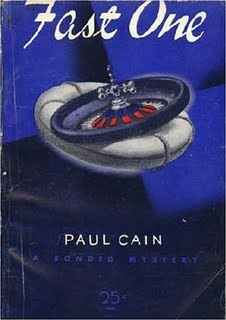 Believe me, those two are not kidding.
Believe me, those two are not kidding.
Fast One is the story of Gerry Kells, an East Coast gambler ensconced in L.A. Local kingpin Jack Rose, seeing a gang war coming, wants Kells on his side. Kells is content to stay neutral, so Rose frames him for murder. Kells then decides to seize control of the city’s rackets himself. The only problems are Rose, L.A.’s other crooks, some interested out-of-town players, the deeply bent police department, the equally suspect power structure, a woman he can’t trust, and his own appetites. And he still damn near pulls it off.
Originally serialized in Black Mask, Fast One is terse almost to the point of incomprehensibility; Cain not only omits needless words, he skimps on a few of the useful ones as well. I had to turn back a few pages on a regular basis. That didn’t diminish the blazing speed with which the book moved, and the fever dream of corruption that it creates. Fast One may not be a good book, but it is a singular one, and it deserves its reputation.
Cain was born George Carrol Sims but called himself Peter Ruric when he worked as a screenwriter. He had an affair with actress Gertrude Michael, a Chez K favorite, basing the character of the duplicitous and dipsomaniacal Miss Granquist on her. Knowing that only enhanced my enjoyment of the book.
Update: The Rap Sheet paired this post in its Friday’s Forgotten Books round-up along with another take on Fast One from Evan Lewis at Davy Crockett’s Almanack. More good information over there.
Sunday, February 07, 2010
Book: Hardboiled Hollywood, by Max Décharné (U.S. 2010)
My first problem? This new reprint of a 2003 No Exit book is called Hardboiled Hollywood, yet two of the eleven movies in it – Hell is a City and Get Carter – are as English as Bobby Charlton eating crisps at a snooker match.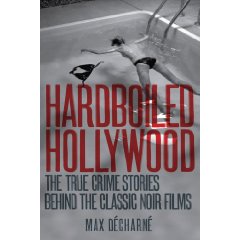 The bigger problem? It’s subtitled The True Crime Stories Behind the Classic Noir Films. Which led me to believe that it would be about the true crime stories behind the classic noir films. Silly Vince. In truth not even half the movies covered have specific historical antecedents, and those are dispensed with in cursory fashion. Some prime candidates are overlooked; despite numerous references to James M. Cain there are no chapters on Double Indemnity or The Postman Always Rings Twice, both inspired by an actual murder. Instead the focus is on the well-trod ground of the making of the films themselves.
The bigger problem? It’s subtitled The True Crime Stories Behind the Classic Noir Films. Which led me to believe that it would be about the true crime stories behind the classic noir films. Silly Vince. In truth not even half the movies covered have specific historical antecedents, and those are dispensed with in cursory fashion. Some prime candidates are overlooked; despite numerous references to James M. Cain there are no chapters on Double Indemnity or The Postman Always Rings Twice, both inspired by an actual murder. Instead the focus is on the well-trod ground of the making of the films themselves.
(ASIDE: In the interests of completeness I’ll also say that it’s appalling publisher W.W. Norton would release a book with jacket copy citing “Anthony Perkin’s” performance in Psycho. Here’s the rule: if you’re not sure where the apostrophe goes, leave it out. Better we think you forgot it.)
That said ... misleading title aside I enjoyed Hardboiled Hollywood. Décharné knows the terrain, writes with passion, and consistently turns up overlooked perspectives. Here’s a great quote from the Spectator on Nicholas Ray and They Live By Night: “If the director had taken the trouble to be French, we would be licking his boots in ecstasy.” The Get Carter material is particularly strong, with Décharné rightly taking director Mike Hodges to task for his misinterpretation of the word “nails” in Ted Lewis’ source novel Jack’s Return Home. Décharné correctly points out that the Parker in Richard Stark’s The Hunter is smarter and more ruthless than Lee Marvin’s incarnation in Point Blank. And it’s good to be reminded that Bonnie and Clyde were not folk heroes but venal small-time killers.
There’s some bait and switch involved, but Hardboiled Hollywood is worth reading.
Miscellaneous: Golden Boot Link
Author and noir historian Alan K. Rode attends the Golden Boot Award ceremony for legendary stuntman Bob Hoy.
Wednesday, February 03, 2010
Books: Kith and Kindle
During the week that Amazon got into a feud with Macmillan (fragging Macmillan’s authors in the process) and Apple introduced the iPad, I finally received my Kindle. Once again demonstrating the flawless timing that has made Keenans valued participants in ballroom dances, cavalry raids and open mic nights throughout history.
(ASIDE #1: Want cogent commentary on Amazon v. Macmillan? Read John Scalzi. Everyone else is. As for the iPad, I’ve lived to the biblical age of however old I am without buying a single Apple product. I’m not about to start now.)
I dithered about the decision to purchase a Kindle for months. By rights I should have been an early adopter; I’m e-reading’s ideal customer. I love books but am rigorously unsentimental about them as physical objects. I want the stories, not the pages.
Money kept me on the fence. Not only the cost of the device but the fact that many of the books I read come courtesy of Seattle’s excellent public library. I can work their hold system like a pinball machine. Graze it with my hip and new releases tumble my way.
But the SPL, feeling the economic pinch, has been forced to make changes. They’ve capped the number of titles you can reserve. And they’ve added a fee to an essential service for researching: interlibrary loans. I could request titles the SPL didn’t carry and a few weeks later a copy would turn up, marked with an orange band. The book, borrowed from the Cerritos, California library or a small college in Minnesota, would be my responsibility for two weeks, a charge I took seriously.
A few weeks ago I had my nose pressed to the Kindle store’s window when I noticed that a research book I wanted for a project, unavailable at the library and retailing for forty dollars, could be mine for only five bucks over the ILL fee. Wheels started turning.
(ASIDE #2: Yes, naysayers, I know that I don’t technically own a book on my Kindle, that I only license it and have therefore allowed the serpent of copyright into my intellectual garden. Or something. For good or ill, this doesn’t bother me.)
Then another discovery. Years ago I’d had a conversation with a book store owner who told me that the three most hardboiled novels were Green Ice by Raoul Whitfield, Fast One by Paul Cain, and Jonathan Latimer’s legendary, censored Solomon’s Vineyard. (I give you no less an authority than James Reasoner on that last title’s history and worth.) I’d found a copy of Green Ice – truth be told, I didn’t care for it – but not the others, aside from imperfect online and POD editions.
The Kindle store had both. Total cost: $4.98.
And so, I placed my order.
It was strange to fire up the Kindle and see the text of John Buntin’s L.A. Noir, which I’d read in hard copy, without page numbers. The interface was simple and intuitive. The e-ink display was astonishingly easy on the eyes. I opened Solomon’s Vineyard, read the introductory note promising “everything but an abortion and a tornado,” and scrolled to Chapter One.
From the way her buttocks looked under the black silk dress, I knew she’d be good in bed. The silk was tight and under it the muscles worked slow and easy. I saw weight there, and control, and, brother, those are things I like in a woman. I put down my bags and went after her along the station platform.
I don’t know about you, but if I found that smeared on shopping bags I’d keep reading. Which is what I did, devouring half of the book in a single sitting, never aware that I was looking at a screen, letting words written 70 years ago work their magic.
And having the text-to-speech voice read that Latimer paragraph aloud? Priceless.
Miscellaneous: Links
My friend award-winning sportswriter Mike Gasparino has launched Metsanity, a new blog about our mutual favorite team. Go. Read. Enjoy.
My friend award-winning author Christa Faust inked her new deal, then inked her new deal.
Get your genres confused? Donna Moore sorts it all out.
Monday, February 01, 2010
Miscellaneous: Weekend Roundup
Wallander. Don’t ask me to compare these BBC adaptations to Henning Mankell’s novels about Swedish detective Kurt Wallander. I’m woefully unschooled in Scandinavian crime fiction, a failing I will soon remedy thanks in part to these films. They have a striking look, the Swedish locales shot in part by last year’s Academy Award winning cinematographer Anthony Dod Mantle. Kenneth Branagh is sensational as Wallander, a compassionate investigator who is never fully present in his own life. The ninety-minute running times allow the personal scenes room to breathe. Sometimes they overwhelm the mystery; I was more involved in Wallander’s reconciliation with his troubled artist father (David Warner in Old Testament prophet mode) than the main story in Sidetracked. The films improve as they go; the last, One Step Behind, is as good as television gets. All three are suffused with a weary, bone-deep sadness that’s haunting.
Whatever Works (2009). Minor Woody Allen, but still entertaining. The movie’s notion that living in New York makes you a better person is naïve, but I happen to agree with it. Larry David’s inability to be anyone other than Larry David actually helps to put it over. A pleasant surprise.
Girls on the Loose (1958). The lovely Mara Corday leads a distaff team of heisters in a payroll job. I don’t know why she turns to crime. She says something about needing to live on the edge, but I think it’s because she’s going broke booking her gamine sister’s Bohemian burlesque act in her nightclub. Mara assembles some crew: a nervous wreck, an alcoholic French beautician, and a truck-stop tough blonde (Joyce Barker, a true Gold Medal gorgon who only appeared in this movie). The whole enterprise is nicely sleazy – Joyce is a masseuse! – and not all that badly plotted. Amazingly it’s directed by Casablanca’s Victor Laszlo, Paul Henreid. That this movie is not on DVD is a travesty. Here’s the trailer.